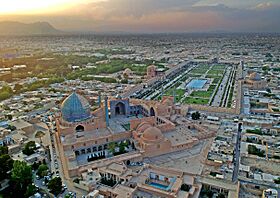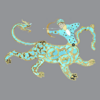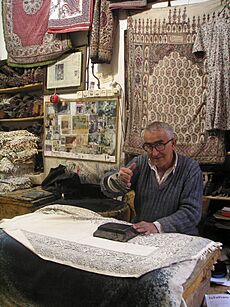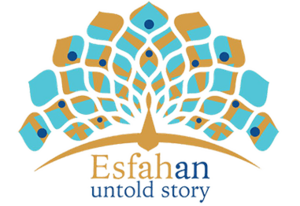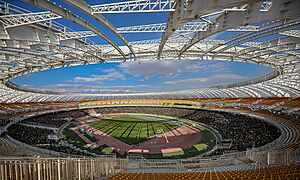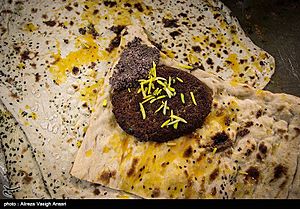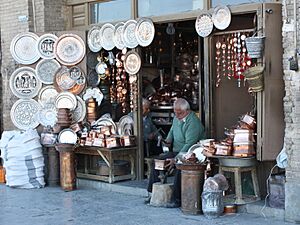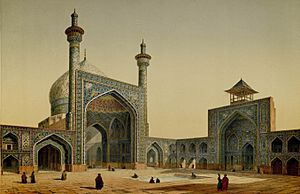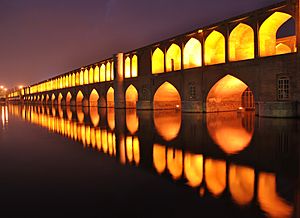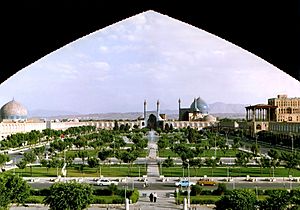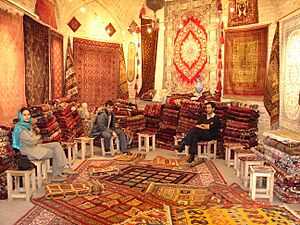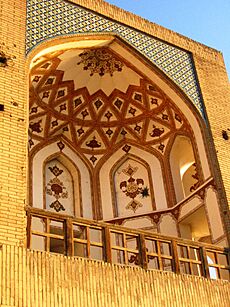Esfahān facts for kids
Quick facts for kids
Isfahan
اصفهان
Spahân, Aspadana
|
|||||
|---|---|---|---|---|---|
|
Clockwise from top: View of the city and Naqsh-e Jahan Square; Khaju Bridge; Chehel Sotoun; Vank Cathedral; Shah Mosque; Flower Garden of Isfahan; and view from Qeysarie Gate
|
|||||
|
|||||
| Nickname(s):
Nesf-e Jahān (Half of the World)
|
|||||

Isfahan
|
|||||
| Country | Iran | ||||
| Province | Isfahan | ||||
| County | Isfahan | ||||
| District | Central | ||||
| Area | |||||
| • Urban | 551 km2 (213 sq mi) | ||||
| Elevation | 1,574 m (5,217 ft) | ||||
| Population
(2022 Census)
|
|||||
| • Urban | 2,219,343 | ||||
| • Metro | 3,989,070 | ||||
| • Population Rank in Iran | 3rd | ||||
| Time zone | UTC+3:30 (IRST) | ||||
| Area code(s) | 031 | ||||
| Climate | BWk | ||||
| Website | isfahan.ir | ||||
Isfahan (pronounced Ees-fa-hahn) is a very important city in Iran. It's the capital of the Isfahan province and is located about 440 kilometers (273 miles) south of Tehran, Iran's capital. With about 2.2 million people, it's the third-largest city in Iran.
Isfahan is special because it sits where two main travel routes in Iran cross: one going north-south and another going east-west. This location helped it become a thriving city between the 9th and 18th centuries. It was even the capital of Iran twice, especially during the Safavid Empire under Abbas the Great. The city is famous for its beautiful Persian and Islamic buildings, wide streets, old bridges, palaces, and mosques with colorful tiles. People in Iran have a saying: Esfahān nesf-e-jahān ast, which means "Isfahan is half the world," showing how famous and beautiful it is. Naqsh-e Jahan Square in Isfahan is one of the biggest city squares in the world and is recognized as a UNESCO World Heritage Site.
Contents
- What's in a Name?
- Isfahan Through Time
- Where Isfahan Is Located
- Getting Around Isfahan
- Isfahan's Economy
- Fun Things to Do in Isfahan
- People of Isfahan
- Places of Worship
- City Management
- Learning and Science
- Isfahan's Culture
- Historical Places to Visit
- Isfahan's Global Connections
- Famous People from Isfahan
- Images for kids
- See also
What's in a Name?
The name Isfahan comes from an old Persian word, Spahān, which means "place of gathering for the army." This name was used a long, long time ago. Over time, the name changed a bit to what we call it today.
Isfahan Through Time
People have lived in the Isfahan area for a very long time, even since the Stone Age. Scientists have found ancient tools and items from many different time periods here.
Early Settlements
The city of Isfahan likely started to grow during the Elamite civilisation, which was around 2700 to 1600 BCE.
Ancient Empires and Religions
Under the Medes, Isfahan became an important trading center. It had very fertile land near the Zayandehrud River.
When Cyrus the Great created the Achaemenid Empire, Isfahan was a place where different religions and people lived together peacefully. Cyrus allowed Jewish people who had been taken to Babylon to return home. Some of them chose to settle in Isfahan because they felt the land and water were similar to Jerusalem.
Later, the Parthians also ruled here. They kept the city important, and it continued to grow. The Sassanids followed, bringing big changes like new farming methods and a revival of Iranian culture. During this time, Isfahan was known as Aspahan or Spahan, meaning "place of the army," because it was a strategic spot for soldiers.
The Muslim Era
When the Arabs took over Isfahan in 642 CE, it became the capital of a region called "the Mountains." The city became very rich under the Buyid dynasty in the 10th century.
Then, in the mid-11th century, Toghril Beg, the founder of the Seljuq dynasty, made Isfahan his capital. His grandson, Malik-Shah I, made the city even bigger and more beautiful.
After the Seljuqs, Isfahan faced a tough time. In 1387, the warlord Timur attacked the city. Sadly, after a revolt, Timur ordered a terrible event where many citizens lost their lives.
Isfahan became important again during the Safavid period (1501–1736). Its most famous time began in 1598 when Abbas the Great made it his capital. He rebuilt the city, making it one of the largest and most beautiful in the 17th century. He encouraged trade along the Silk Road and brought skilled workers, including Armenians and Georgians, to live and work in the city. This helped Isfahan become a center of art and culture. A special area called New Julfa was created for the Armenians.
The city's great success lasted until it was attacked by Afghan invaders in 1722. After this, Isfahan became less important, and the capital moved to other cities before finally settling in Tehran.
Modern Isfahan
In the 19th century, people started working to protect Isfahan's old and important buildings. In the 20th century, many people moved to Isfahan, especially after the Iran–Iraq War in the 1980s.
Today, Isfahan is known for making beautiful carpets, textiles, steel, and traditional foods. It's especially famous for the Isfahan rug. The city also has important industrial facilities, including one of the biggest steel producers in the Middle East, the Mobarakeh Steel Company. There are also facilities for making nuclear fuel (for energy research) and an aircraft manufacturing plant. Isfahan even hosted the International Physics Olympiad in 2007, a big science competition for students.
The city is always looking to the future, with new projects like a tourism app and modern city planning.
Where Isfahan Is Located
Isfahan is built on a flat area near the Zayandeh Rud (which means "Fertile River") and at the foot of the Zagros mountains. The closest mountain is Mount Soffeh, just south of the city.
Waterways and Canals
For hundreds of years, people in Isfahan have built special canals called madi to bring water from the Zayandeh Rud river to different parts of the city. This clever system was designed by an engineer named Sheikh Bahaï during the Safavid era.
Environmental Challenges
Like many places, Isfahan faces environmental issues. The Zayandeh Rud river sometimes runs dry, which affects the city's green spaces and the people living nearby. This is often due to water management challenges. The city is also working on improving its air quality.
Plants and Animals
The beautiful Damask rose flower, especially a type called Rosa 'Ispahan', is named after the city. Sadly, some local animals, like a type of cow, have become extinct. You can often see wagtails (small birds) in the farmlands and parks. The city is trying to plant more trees, especially those that can survive with less water.
Isfahan's Climate
Isfahan has a cold desert climate. Even though it's high up in the mountains, summers can be hot, but the nights are usually pleasant. Winters are cool, and it snows a few days each year. The city is generally very dry, getting much less rain than other major Iranian cities. The Zayande River is very important for the city's water supply.
| Climate data for Isfahan (1991–2020, records 1951-present) | |||||||||||||
|---|---|---|---|---|---|---|---|---|---|---|---|---|---|
| Month | Jan | Feb | Mar | Apr | May | Jun | Jul | Aug | Sep | Oct | Nov | Dec | Year |
| Record high °C (°F) | 20.8 (69.4) |
25.0 (77.0) |
30.0 (86.0) |
32.6 (90.7) |
38.5 (101.3) |
42.1 (107.8) |
44.6 (112.3) |
43.8 (110.8) |
39.2 (102.6) |
34.0 (93.2) |
27.5 (81.5) |
23.4 (74.1) |
44.6 (112.3) |
| Mean daily maximum °C (°F) | 10.0 (50.0) |
13.6 (56.5) |
18.0 (64.4) |
23.4 (74.1) |
29.2 (84.6) |
35.2 (95.4) |
37.6 (99.7) |
36.2 (97.2) |
32.4 (90.3) |
25.8 (78.4) |
17.1 (62.8) |
11.7 (53.1) |
24.2 (75.5) |
| Daily mean °C (°F) | 3.4 (38.1) |
6.8 (44.2) |
11.4 (52.5) |
16.8 (62.2) |
22.3 (72.1) |
27.9 (82.2) |
30.3 (86.5) |
28.5 (83.3) |
24.4 (75.9) |
17.9 (64.2) |
9.9 (49.8) |
4.9 (40.8) |
17.0 (62.7) |
| Mean daily minimum °C (°F) | −2.8 (27.0) |
−0.1 (31.8) |
4.6 (40.3) |
9.7 (49.5) |
14.5 (58.1) |
19.2 (66.6) |
21.7 (71.1) |
19.5 (67.1) |
15.3 (59.5) |
9.6 (49.3) |
3.1 (37.6) |
−1.1 (30.0) |
9.4 (49.0) |
| Record low °C (°F) | −19.4 (−2.9) |
−12.2 (10.0) |
−8.3 (17.1) |
−4.0 (24.8) |
4.5 (40.1) |
10.0 (50.0) |
13.0 (55.4) |
11.0 (51.8) |
5.0 (41.0) |
0.0 (32.0) |
−8.0 (17.6) |
−13.0 (8.6) |
−19.4 (−2.9) |
| Average precipitation mm (inches) | 20.2 (0.80) |
15.9 (0.63) |
27.1 (1.07) |
20.8 (0.82) |
9.4 (0.37) |
1.7 (0.07) |
0.7 (0.03) |
0.3 (0.01) |
0.1 (0.00) |
3.2 (0.13) |
18.2 (0.72) |
18.2 (0.72) |
135.8 (5.37) |
| Average snowfall cm (inches) | 7.7 (3.0) |
0.3 (0.1) |
0.1 (0.0) |
0.0 (0.0) |
0.0 (0.0) |
0.0 (0.0) |
0.0 (0.0) |
0.0 (0.0) |
0.0 (0.0) |
0.0 (0.0) |
0.1 (0.0) |
2.4 (0.9) |
10.6 (4) |
| Average precipitation days (≥ 1.0 mm) | 3.6 | 2.7 | 3.8 | 3.6 | 1.6 | 0.3 | 0.1 | 0.1 | 0.0 | 0.7 | 2.6 | 3.2 | 22.3 |
| Average snowy days | 2.1 | 0.1 | 0.4 | 0.1 | 0.0 | 0.0 | 0.0 | 0.0 | 0.0 | 0.0 | 0.0 | 0.7 | 3.4 |
| Average relative humidity (%) | 56 | 43 | 37 | 35 | 29 | 19 | 19 | 20 | 22 | 33 | 48 | 59 | 35 |
| Average dew point °C (°F) | −5.8 (21.6) |
−6.3 (20.7) |
−4.9 (23.2) |
−0.6 (30.9) |
1.3 (34.3) |
0.8 (33.4) |
3.1 (37.6) |
2.5 (36.5) |
0.1 (32.2) |
−0.3 (31.5) |
−1.8 (28.8) |
−3.5 (25.7) |
−1.3 (29.7) |
| Mean monthly sunshine hours | 210 | 228 | 255 | 262 | 317 | 358 | 356 | 358 | 322 | 286 | 217 | 199 | 3,368 |
| Source 1: NOAA NCEI, (snowfall 1981-2010) | |||||||||||||
| Source 2: Iran Meteorological Organization (records), | |||||||||||||
Getting Around Isfahan
Isfahan has a growing network of highways that connect it to other major cities like Tehran and Shiraz. The city also has a good public transport system.
Famous Bridges
The bridges over the Zayandeh Rud river are some of Isfahan's most beautiful sights.
- The Shahrestan Bridge is the oldest, with parts dating back to the 3rd-7th centuries.
- The Khaju Bridge, built in 1650, is 123 meters (404 feet) long and has 24 arches.
- The Choobi (Joui) Bridge used to carry water to palace gardens.
- The Si-o-Seh Pol, or "bridge of 33 arches," is the longest at 295 meters (968 feet). It was built in the 17th century and connected Isfahan to the Armenian neighborhood of New Julfa.
- The Marnan Bridge is another notable bridge.
Public Transport
Isfahan has a bus system and a Bus Rapid Transit (BRT) line that carries many passengers daily. The city also has a metro (subway) system with one line open and more being built. There are plans for a tram network too.
For longer journeys, Isfahan has a train station with routes to other Iranian cities. A new high-speed railway is also being built to connect Isfahan to Tehran and Qom.
Air Travel
Isfahan International Airport serves the city, connecting it to other places by air.
Isfahan's Economy
Isfahan province contributes a lot to Iran's economy, especially in industry, mining, and trade. Tourism is also a top priority for the region.
Local Products and Industries
Isfahan is known for its beautiful handicrafts, especially Persian rugs made of wool and silk. The city also produces textiles, steel, and traditional sweets.
The Mobarakeh Steel Company in Isfahan is the biggest steel producer in the Middle East and North Africa. The Isfahan Steel Company was the first in Iran to make construction steel.
The city also has an oil refinery and a large aircraft manufacturing plant called HESA.
Farming and Fishing
Isfahan is a big producer of salmon and ornamental fish. Farmers use a network of ancient canals to bring water from the river to their farms. The city also has a central market where farmers sell their fruits and vegetables.
Technology and Innovation
The Isfahan Scientific and Research Town was started to connect government, industry, and universities to create a knowledge-based economy. Isfahan is also a major center for making medicines in Iran.
Fun Things to Do in Isfahan
Isfahan is a popular place for tourists, with hundreds of thousands of foreign visitors each year.
Parks and Gardens
- Nazhvan Park has a reptile zoo and water parks for children.
- The Flower Garden of Isfahan is a beautiful place to visit.
- The Pardis Honar Park has a large outdoor amphitheater.
Shopping and Markets
You can find many shops and markets in Isfahan, including modern shopping centers like Isfahan City Center and traditional places like the Grand Bazaar, Isfahan.
Cinemas
Isfahan has several cinemas where you can watch movies. Historically, cinemas have been a part of the city's entertainment scene for a long time.
Sports
Isfahan is home to several sports clubs, especially in association football.
- Sepahan S.C. is one of the most successful football clubs in Iran, winning many league titles.
- Zob Ahan Isfahan F.C. is another popular football team.
- Giti Pasand FSC has a very strong futsal (indoor football) team that has won championships in Asia.
- There are also basketball teams like Zob Ahan Isfahan BC.
People of Isfahan
Isfahan is a diverse city. The main dialect spoken is Esfahani, a form of Western Persian. Jewish communities in the city speak their own unique dialect.
The city has grown a lot over the years. In 2019, the average age for first marriages was around 25 for females and 30 for males.
Places of Worship
Isfahan is a city with many different places of worship, showing its rich history and diverse population.
Mosques
There are many beautiful and historic mosques in Isfahan, including:
- Jameh Mosque
- Shah Mosque (built in 1629)
- Sheikh Lotf Allah Mosque (built in 1618)
- Hakim Mosque
Churches and Cathedrals
Most churches are in the New Julfa area, which is the Armenian quarter. Some of the oldest and most famous include:
- St. Jakob Church (1607)
- Vank Cathedral (1664)
- St. Mary Church (1613)
Synagogues
Isfahan also has several synagogues for its Jewish community.
City Management
Isfahan is working to become a "smart city" with modern systems for managing its resources and services. The city government employs many people to keep things running smoothly.
The city is divided into 15 municipal districts, each with its own local administration.
Public Services
The city has services for waste processing and recycling. The Isfahan Water and Sewage Company manages the water supply and sewage systems. There are also fire departments and security services to keep the city safe.
Learning and Science
Isfahan has a long history of education. During World War II, many Polish children found refuge here, and schools were set up for them, earning Isfahan the nickname "City of Polish Children."
Important Schools
Some notable historical schools include:
- Chahar Bagh School (early 17th century)
- Kassegaran school (1694)
There are thousands of schools across Isfahan province.
Universities and Colleges
Isfahan is home to several important universities:
- The Isfahan University of Medical Sciences (established 1947) trains doctors and medical professionals.
- The Isfahan University of Technology (established 1974) is Iran's first technical university, focusing on science, engineering, and agriculture.
- The Isfahan University of Art (established 1977) focuses on arts and culture.
- Other universities include Payame Noor University and various branches of the Islamic Azad University.
- There are also many technical and vocational training centers that offer free skill-building programs.
Famous Thinkers
Isfahan has been home to important philosophers like Mir Damad, who founded the "School of Isfahan," and Mir Fendereski, known for his ideas on art and philosophy.
Isfahan's Culture
Isfahan has rich ancient traditions and a vibrant cultural scene. The "Isfahan School" of painting was very popular during the Safavid era.
The city hosts an annual theater festival, and there are several active theaters. Isfahan also has an annual literature prize. November 22 is celebrated as Isfahan's National Day with various events.
Local Food
Isfahan is famous for its unique foods and snacks:
- Gosh-e fil (an ear-shaped pastry) and Doogh (a yogurt drink) are popular snacks.
- Traditional meals include Khoresht mast (a yogurt stew) and Beryani (a meat dish).
- Gaz and Poolaki are two popular Iranian candies that come from Isfahan.
Music
The Bayat-e Esfahan is a special musical style used in traditional Iranian music.
News and Media
The first newspaper in Isfahan, Farhang, was printed during the Qajar era. Today, the city has its own news agency and local TV and radio channels.
Historical Places to Visit
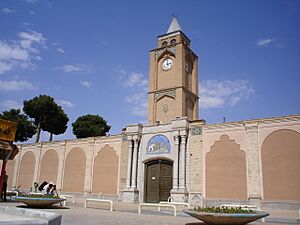
Isfahan's city center has an old section around the Jameh Mosque and a newer section built during the Safavid era around Naqsh-e Jahan Square.
Old Baths
Many ancient public baths, called hammam, can be found in Isfahan, like the Jarchi hammam.
Bazaars (Markets)
The Grand Bazaar, Isfahan and its entrance, the Qeysarie Gate, were built in the 17th century. These are great places to explore and shop for handicrafts.
Gardens and Parks
Besides the ones mentioned earlier, Isfahan has other beautiful gardens and parks, including the Birds Garden and the Nazhvan Recreational Complex.
Historic Houses
Isfahan has many beautiful old houses that show traditional Persian architecture, such as the Alam's House and the Amin's House.
Tombs and Mausoleums
You can visit several historical tombs and mausoleums, like the Al-Rashid Mausoleum (12th century) and the Nizam al-Mulk Tomb (11th century).
Tall Minarets
Isfahan is known for its tall minarets (towers usually found next to mosques), including the famous Menar Jonban (built in the 14th century) and the Ali minaret (11th century).
Museums
The city has several museums, such as the Museum of Contemporary Art and the Natural History Museum of Isfahan.
Palaces and Caravanserais
Isfahan is home to magnificent palaces:
- Ali Qapu (Imperial Palace, early 17th century)
- Chehel Sotoun (Palace of Forty Columns, 1647)
- Hasht Behesht (Palace of Eight Paradises, 1669)
Squares and Streets
- Naqsh-e Jahan Square (also known as Shah Square or Imam Square, built in 1602) is a must-see.
- Chaharbagh Boulevard (1596) is a historic and beautiful street.
Isfahan's Global Connections
Since 1994, Isfahan has been part of the League of Historical Cities, connecting it with other historic cities around the world. It also works with other cities to share cultural ideas.
Isfahan is a "twin city" with many cities globally, which means they have special friendly relationships and work together on projects.
Sister Cities
 Baalbek, Lebanon (2010)
Baalbek, Lebanon (2010) Dakar, Senegal (2009)
Dakar, Senegal (2009) Florence, Italy (1998)
Florence, Italy (1998) Freiburg im Breisgau, Germany (2000)
Freiburg im Breisgau, Germany (2000) Havana, Cuba (2001)
Havana, Cuba (2001) Iași, Romania (1999)
Iași, Romania (1999) Kuala Lumpur, Malaysia (1997)
Kuala Lumpur, Malaysia (1997) Kuwait City, Kuwait (2000)
Kuwait City, Kuwait (2000) Lahore, Pakistan (2004)
Lahore, Pakistan (2004) Saint Petersburg, Russia (2004)
Saint Petersburg, Russia (2004) Yerevan, Armenia (2000)
Yerevan, Armenia (2000) Xi'an, Shaanxi, China (1989)
Xi'an, Shaanxi, China (1989) Samarkand, Uzbekistan (2021)
Samarkand, Uzbekistan (2021) Porto, Portugal (2021)
Porto, Portugal (2021)
Famous People from Isfahan
Many talented people have come from Isfahan, including:
- Musicians
- Jalal Taj Esfahani (1903–1981)
- Alireza Eftekhari (1956–), singer
- Leila Forouhar (1959–), pop singer
- Actors and Directors
- Homayoun Ershadi (1947–), Hollywood actor
- Soraya Esfandiary-Bakhtiari (1956–2001), former princess and actress
- Artists
- Mahmoud Farshchian (1930–), famous painter and miniaturist
- Political Figures
- Mohammad-Ali Foroughi (1875–1942), a former Prime Minister of Iran
- Mohammad Javad Zarif (1960–), former Minister of Foreign Affairs
- Religious Leaders
- Lady Amin (Banou Amin) (1886–1983), a highly respected female scholar
- Allamah al-Majlisi (1616–1698), an important religious leader
- Sports Stars
- Arsalan Kazemi (born 1990), basketball player for the Iran national team
- Sohrab Moradi (1988–), Olympic gold medalist in weightlifting
- Writers and Poets
- Mohammad-Ali Jamālzādeh Esfahani (1892–1997), author
- Houshang Golshiri (1938–2000), writer
Images for kids
See also
 In Spanish: Isfahán para niños
In Spanish: Isfahán para niños
- New Julfa
- List of the historical structures in the Isfahan province
- Isfahan Zoo


